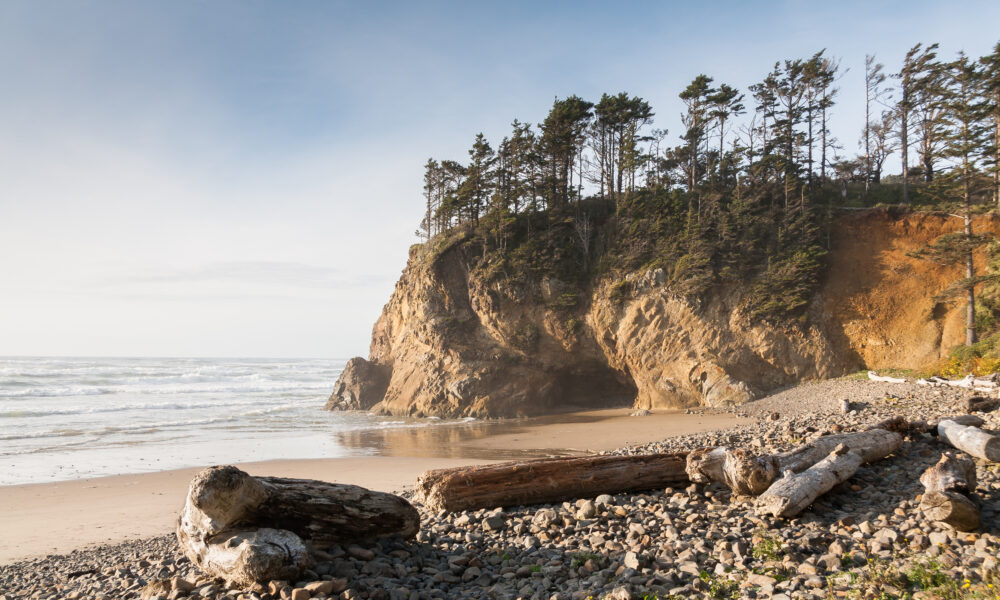
Hug Point, Oregon
Hug Point gets its name from a practical problem: getting around it without getting wet. Back in the 1800s, stagecoaches had to literally “hug” this rocky outcrop at low tide since the beach was the only road along this part of the Oregon coast.
The park started small – just 1.3 acres given by Clatsop County in 1957 but has since grown to its current 43 acres. You can still see the wheel ruts from those old stagecoaches when the tide is out. Here’s why it one of the highlights on any trip this side of Oregon.

When Beaches Were the Only Roads
Before Highway 101 existed, the beach was the main road along this stretch of coast.
Stagecoach drivers had to carefully time their trips with the tides and hug the point closely to avoid getting swamped.
Around 1910, workers blasted through the rocky headland to make a better road at the base of Hug Point for vehicles crossing at low tide. Some people claim the road was built in the 1920s after a car got stuck, but photos show it was there before 1920.
You can still see wheel ruts carved into the rock, physical proof of this unique chapter in Oregon’s transportation history.

The Forgotten House Above the Waterfall
A now-gone house once stood above the waterfall at Hug Point. The Fashers family built it in the 1930s, using local materials like cedar shake and ship-lap.
They eventually gave the property to the state in 1968. Later tenants tried to save the house, arguing it was historically important. But Oregon State Parks decided it spoiled the natural setting and tore it down in the late 1970s.

The Bird That Was Never Seen in America
Hug Point recently made headlines in the bird world. In April 2024, a middle school teacher named Michael Sanchez took a photo of a Blue Rock Thrush here – the first confirmed sighting of this bird in the United States.
This rare bird normally lives in Europe and Asia, and hadn’t been seen in North America since a disputed sighting in British Columbia back in 1997.
Bird enthusiasts rushed to Hug Point hoping to see this rare visitor. Just days later, another Blue Rock Thrush appeared 500 miles south near San Francisco, raising questions about whether it was the same bird or a different one.

Million Year Old Rock Formations
The rocks at Hug Point tell a story millions of years in the making. The headland features a mix of sandstone and basalt, with a striking dark basalt layer running through lighter sandstone in the cliff.
Over thousands of years, waves have shaped the coastline, carving sea caves and forming tide pools in the irregular rock formations.
Looking south from the beach, you’ll see Point Meriwether Headland with dramatic basalt sea stacks rising from the water. These rock features create perfect homes for many marine creatures in the tide pools that form when the water is low.

A Stream Runs Through the Sand
The heart of Hug Point is its beautiful sandy beach. It stretches from Arch Cape in the south all the way to Arcadia Beach in the north, giving you plenty of room to wander and relax. A small stream crosses the beach, creating a pretty scene as it flows into the ocean.
Look behind you and you’ll see hills covered with native plants, salal, ferns, and Sitka spruce – creating a green backdrop to the sandy shore.

Caves You Can Only Reach at Low Tide
When the tide is low, you can explore the sea caves at Hug Point. These caves were formed by waves slowly eroding the sandstone cliffs along the headland’s south side. One of the larger caves goes surprisingly far back into the cliff for those brave enough to venture inside.
Look for colorful algae covering the rock walls and the many tide pools where you can find starfish, anemones, and other marine life.

A Waterfall That Flows Right Onto the Beach
One of the coolest things about Hug Point is its beach waterfall. Just north of the main beach, Fall Creek drops directly onto the sand, creating one of the few waterfalls on the Oregon coast that flows right onto a beach.
The waterfall looks best during spring or after heavy rain. In summer, it often shrinks to a small trickle. The morning light hitting the waterfall against the dramatic cliffs creates an almost magical scene that photographers love.

More Things to Do at Hug Point
Many people come for picnics, fishing along the shore, tide-pooling, or long walks on the beach. If you enjoy photography, you’ll find endless subjects: the waterfall, sea caves, wildlife, and sweeping coastal views.
Birdwatching has become even more popular since the rare Blue Rock Thrush sighting, with many other bird species visible throughout the year.
While not a formal hiking trail, the beach walks and exploration around the headlands provide good exercise with amazing views.

Cannon Beach
Just five miles north of Hug Point sits Cannon Beach, one of Oregon’s favorite coastal towns. You might spot Cannon Beach’s famous Haystack Rock on a clear day (a massive 235-foot sea stack standing in the water).
When you need a break from nature, Cannon Beach offers great restaurants, art galleries, and boutique shops. Many people stay in Cannon Beach and make day trips to Hug Point, choosing from accommodations that range from fancy resorts to cozy B&Bs.
The two locations are close enough to visit in a single day, letting you experience both a developed beach town and a more natural setting.

Ecola State Park
North of Cannon Beach, you’ll find Ecola State Park with nine miles of gorgeous coastline that pairs perfectly with a trip to Hug Point.
The park features old-growth forests, steep cliffs, and trails with some of the best views on the Oregon coast. You can check out an abandoned lighthouse, walk through thick green forests, and stop at several lookouts over the Pacific.
Keep your eyes open for wildlife: Roosevelt elk, eagles, and harbor seals are common sights throughout the park. Movie buffs might recognize parts of Ecola State Park from films like “The Goonies,” “Twilight,” and “Point Break”.

Oswald West State Park
Drive a short distance south of Hug Point to find Oswald West State Park, which covers 2,500 acres of coastal rainforest with four miles of protected shoreline.
The park is named after a former Oregon governor who helped ensure Oregon’s beaches would remain public. Many trails wind through dense forests with ancient Sitka spruce and western red cedar trees.
For a great hike with an amazing payoff, try the Cape Falcon Trail. Short Sands Beach at the trail’s base is popular with surfers and offers more shelter on the Oregon coast.

Getting There and Staying Safe
Hug Point State Recreation Site is open year-round with no entrance fees. You’ll find clean restrooms, a good-sized parking lot (that fills up during busy times), and picnic areas near where you park.
To reach the beach, take a short walkway and stairs from the parking area. The waterfall and caves require walking north along the beach.
The most important thing to know: check tide tables before you go.
High tide can cut off access to the caves, waterfall, and historic roadbed, potentially stranding you. For safety, check tideschart.com before exploring around the point. Also, don’t fly drones here, they’re prohibited to protect nesting shorebirds.
The post A Seasonal Waterfall Meets Ocean Waves at This Oregon Beach with a Dangerous History appeared first on When In Your State.




![Tyson Foods Plant [Photo: Food Manufacturing]](https://southarkansassun.com/wp-content/uploads/2023/08/iStock_1185520857__1_.5e441daa51cca-600x337.jpg)







![Silverado Senior Living Management Inc. [Photo: Los Angeles Times]](https://southarkansassun.com/wp-content/uploads/2023/10/download-6-4-600x337.jpg)

![China's Wuhan Institute of Virology [Photo: Nature]](https://southarkansassun.com/wp-content/uploads/2023/09/d41586-021-01529-3_19239608-600x337.jpg)
















